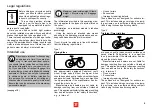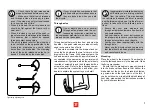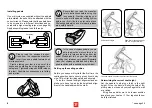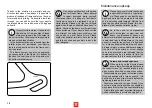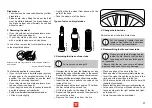
2
Modern braking systems might be
more powerful or have a different
functionality than those that you are
used to. Please familiarise yourself with the
brakes on a safe piece of land before setting
off on your first ride with the bicycle!
If you use a bicycle with carbon fibre rims,
please note that this material provides a sig-
nificantly worse braking effect in combination
with rim brakes than aluminium rims do!
Also remember that the effectiveness of
brakes can be different, often worse, than you
are used to in wet conditions or on slippery
surfaces. Please take the possibility of longer
braking distances and slippery surfaces into
account when riding!
If you are riding a single speed or a “fixie”,
please familiarise yourself with its behaviour
under braking before your first ride! Single
speed wheels with just one brake are not per-
mitted on public roads. Fixed-gear bikes do not
have a freewheel mechanism. The cranks al-
ways turn whenever the back wheel is turning.
If your bicycle has rubber or plastic
cage pedals, please familiarise your
-
self with the grip which these offer. In
wet conditions, rubber and plastic pedals can
be very slippery!
Gear system
Electrical motor
For your safety
These instructions assume that you can already
ride a bicycle. It is not a teaching manual to help
you learn to ride. Nor is it meant to provide you
with information on setting up or repairing the
bike.
Always be aware that there are basic risks in-
volved in cycling. As a cyclist you are particularly
exposed to risk. Always be aware that you do not
have the same level of protection as you have in
a car, for example. You have neither airbags nor
bodywork around you. However you are travel
-
ling more quickly and in other areas of the road
than a pedestrian. Accordingly, you should pay
particular attention to other road users.
When cycling, never wear headphones or use
a mobile telephone. Never cycle if you are not in
a condition to be in complete control of your bi-
cycle. This applies particularly if you have taken
medicines, alcohol or other drugs.
• If the road surface is
wet or slippery, adjust
your cycling style ac-
cordingly. Cycle more
slowly and brake care-
fully and early, as your
stopping distance is
significantly increased.
• Adjust your speed in accordance with the ter-
rain and your cycling ability.
Your specialist bicycle retailer will be happy to
answer any further questions you have after
reading this manual.
Please ensure that your bicycle is ready for
use and is adjusted to fit your body.
That means:
•
Setting the position and fixture of the seat and
handlebars
• Checking the assembly and settings of the
brakes
• Securing the wheels into the frame and fork
To ensure that you enjoy a safe and comfortable rid-
ing position, please allow your specialist retailer to set
up your handlebars and stem.
Adjust the seat to a safe and comfortable posi-
tion for you (see page 8).
Allow your specialist retailer to set up the brakes
so that the brake levers are always within easy
reach. Ensure that you know which lever operates
which brake (right/left)!
The right brake lever operates the rear wheel
brake, the left brake lever operates the front
wheel brake. Despite this, however, you should
still check if the same rule applies to your bike’s
levers before riding it for the first time, as this can
sometimes vary.
Before the first ride
Please also consult the additional operating
manuals of the individual component manu-
facturers, which were supplied with your bicy
-
cle or available online.









